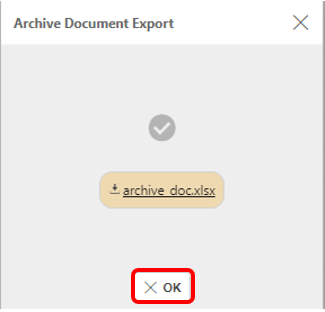Archive Upload: Documents
The purpose of Archives is for users to be able to import their old data from previous systems, which then means they don't need to keep their previous systems turned on.
View Archive Upload: Documents menu
In iplicit, go to the Archive Upload: Documents menu by either selecting Upload: Documents from Archive in the Settings section from the pulse menu -
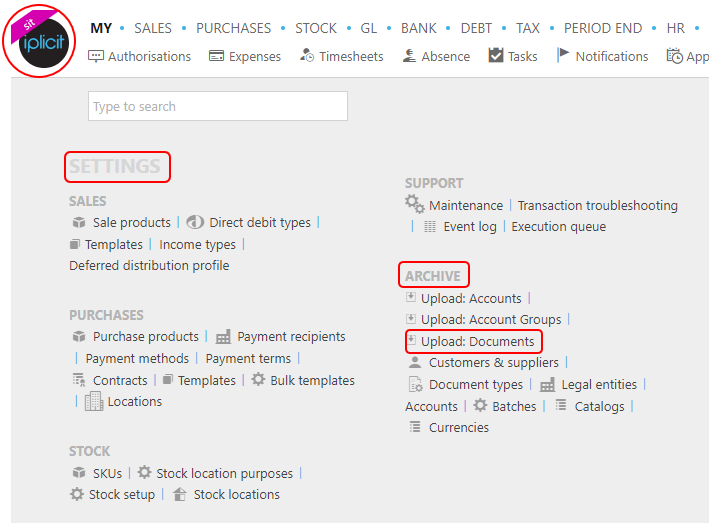
Note
This is an example screen shot of the pulse menu.
Position of the menu items within pulse will vary according to available options and dependant on personal screen resolution.
or enter Archive Upload: Documents in the Quick Launch Side Menu.

This will display Archive Upload: Documents.

Information shown is self-explanatory.
Tip
To modify the columns displayed, select
 in the top right of the page, then untick the information you do not want to see.
in the top right of the page, then untick the information you do not want to see.
Upload Archive Documents
Before running the iplicit process to upload your previous data, you have the responsibility to get your data in the correct format. At the moment, the Archive Upload: Documents process takes the archive data using a spreadsheet format.
The spreadsheet should have the following column headings (in row 1, in same order) -
- source_app
- batch_no
- legal_entity
- legal_entity_description
- doc_type
- doc_type_description
- contact_account
- contact_account_description
- doc_no
- their_doc_no
- their_ref
- doc_date
- tax_date
- due_date
- financial_period
- financial_period_description
- financial_year
- financial_year_description
- product
- product_description
- account
- account_description
- description
- currency
- currency_rate
- uom
- uom_description
- quantity
- net_amount
- net_currency_amount
- net_currency_unit_price
- tax_amount
- tax_code
- tax_code_description
- tax_currency_amount
- tax_rate
- gross_amount
- gross_currency_amount
- gross_currency_unit_price
- base_currency
- cost_centre
- cost_centre_description
- department
- department_description
- doc_line_date
- fund
- fund_description
- bank_account
- bank_account_description
- bank_currency
- bank_currency_amount
- bank_currency_rate
- bank_ref
- project
- project_description
- resource
- resource_description
- analysis_code
- analysis_code_description
- is_manual
- is_non_recoverable
- is_tax_adjustment
- line_no
- payment_method
- payment_method_description
- payment_term
- product_type_code
- vat_return
- created_date
- created_by
- last_modified
Save the spreadsheet to an area that will be accessible to your iplicit system.
Tip
You can create a dummy spreadsheet with the correct column formats by running the Export Archive Accounts below - this will even work if there is no data. Delete any data in the new spreadsheet, if there is any. Just leave row 1, which has the column names, and then you have a blank spreadsheet ready for you to add your data.
Warning
- Upload only supports single Tabs on a spreadsheet. Therefore, if your data is spread over multi tabs you will have to create a separate spreadsheet for each Tab.
Select Archive Upload: Documents menu from one of the options as shown in View Archive Upload: Documents menu above.
Select the Upload button.

In the pop-up box, enter the following information -
- Source App - the name of the Accountancy system you are uploading from.
- File - the name of the spreadsheet file that was created in step 1.
- Batch description - Enter name that you can is easily identify, if you need to see this batch of data only once uploaded.
- Date format - Change the date format if you don't want the default setting.
- Defaults - here you can change the Currency and add a Legal entity.
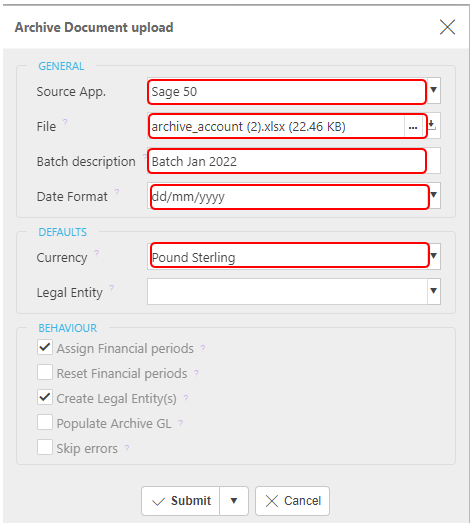
Behaviour Tab -
- Assign Financial periods - tick this checkbox if you wish to assign the Financial year and period (where not specified in the upload). This will use the Start Month on the related Legal Entity and assume a 12 month Financial year.
- Reset Financial periods - tick this checkbox if you wish to reset the Financial year and period (regardless of whether values already exist). This will use the Start Month on the related Legal Entity and assume a 12 month Financial year.
- Create Legal Entity(s) - ticking this checkbox will automatically create Archive Legal Entities which exist in the upload but do not already exist in the Archive Legal Entities.
- Populate Archive GL - tick this box to automatically populate the Archive GL during the upload (where there are no validation errors in the batch).
Select Submit.
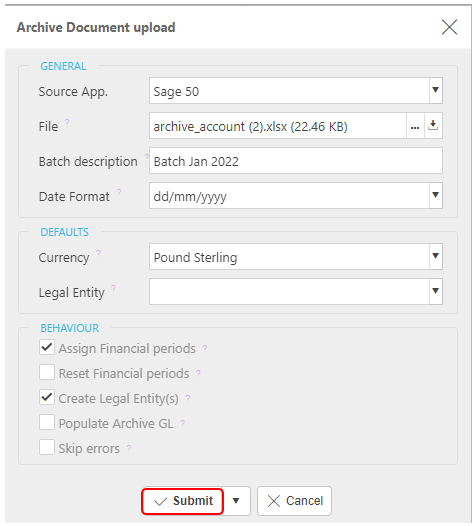
Alternatively, by selecting the
 button, you can Queue the upload. This still Submits the upload but closes the overlay and there's no spinners, so you can carry on using the system whilst it uploads.
button, you can Queue the upload. This still Submits the upload but closes the overlay and there's no spinners, so you can carry on using the system whilst it uploads.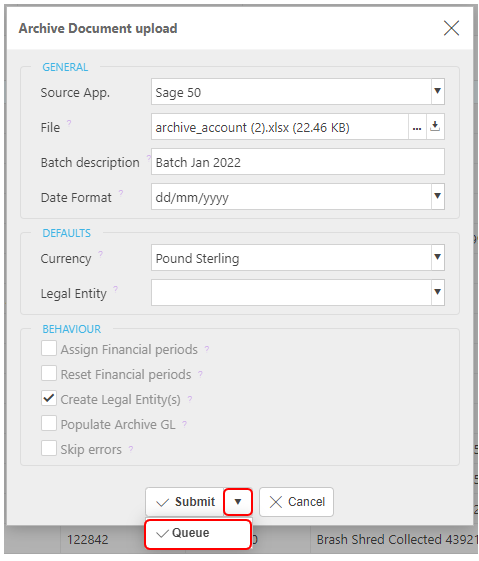
View Archive Documents
You can now view this documents in Archive documents
View Archive GL
If the Populate to Archive GL wasn't selected in Behaviours in step 4 of Uploading Documents, or you want to update the Archive GL then the Archive GL needs repopulating.
Select Archive Upload: Documents menu from one of the options as shown in View Archive Upload: Documents menu above.
Select Repopulate GL button.

Enter the Archive Batch.

Select Submit.

You can now view the Archive GL
Export Archive Documents
Select Archive Upload: Documents menu from one of the options as shown in View Archive Documents menu above.
Select the Export button.

Select Batch(es), Legal entities and Supplier(s) to filter number of records to export.
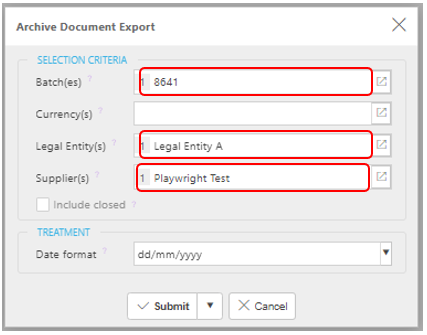
Select Submit.

After the process has completed the following message appears.
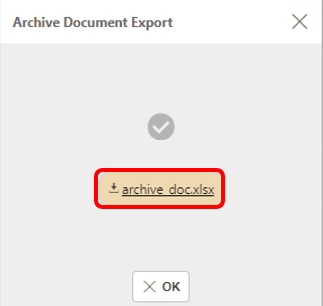
Select the archive account.xlsx to download the excel spreadsheet.
Select OK to continue.
